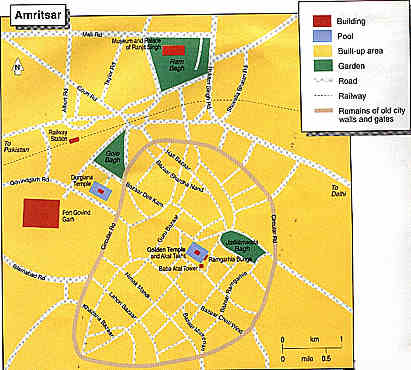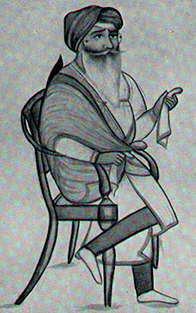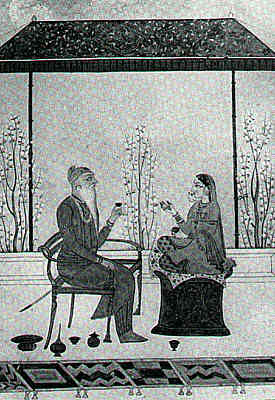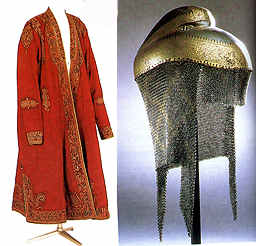PUNJAB -
A Glorious Heritage
Following article - courtesy of Gurbax Singh Shergill, President, Punjab Heritage & Education Foundation, Chandigarh


The natural (geo-physical) and historical heritage of people living in a particular region or state is the essential framework, which is the main source for their socio-economic growth and historic and political evolution. It is the pride and love for this heritage, which determines their collective image and personality. Any person on community, which neglects its heritage is bound to he lost in the layers of history.
The land of Punjab, which acted as cradle for Indian civilization for centuries also remained a route for many foreign invaders and imperial forces. Hence, it developed into conflicting demographic streams. It was on account of Guru Nanak- Guru Gobind Singh's divine message and later on establishment of Sarkar-e-Khalsa under Maharaja Ranjit Singh that a common pride of the land developed and gave rise to Punjabi identity. This pride of regional identity is absolutely necessary for the overall evolution of a growing nation combining diversity into unity.
Our brave struggle against the forei-gn invaders and imperialists has left many historical landmarks, which act as the glorious milestones of our heritage. The holy places, forts, royal palaces, historical gated, sites, gardens, traditional havelis, manuscripts, wall paintings. coins, rare pieces of art and jewellery need our attention for their preservation. The best way is to put them in relevant use for the community without tempering with their essential historic originality. Our natural heritage, hills, forests, rivers, rivulet. wetlands are all in great danger and need our planning and care.
Our best of the human heritage. i.e., our rural youth. is almost Languishing on account of the deteriora-tion of the education system and increasing drug addiction. The great heritage of high moral values. i.e. honesty, hard work and selfless serv-ice once again needs to be our best trait at national and international level.
The Punjab Heritage and Education Foundation have taken the initiative to survey and identify glori-ous heritage sites, which need urgent and immediate attention. The Shiromani Gurdwara Prabandhak Committee (SGPC) and other reli-gious endowments are already looking after the holy places. We have therefore, tried to identify heritage sites from Baba Banda Bahadur onwards under the guidance of renowned historian Dr. Kirpal Singh former professor and head of Punjab Historical Studies, Punjabi University, Patiala.
The first and the foremost heritage site is the Ram Bagh Garden in Amritsar with its Roval Places and Gates, Gardens, watching towers and "Baran Dari" with a beautiful layout of fountains and lawns having rare trees planted by Maharaja Ranjit Singh. The Garden is spread over 84 acres of land. It is appreciable that the Punjab Government has declared the Ram Bagh Garden and its buildings as protected monuments. But in spite of that is remains neglected and is misused and encroached upon the private clubs and some other agencies with-out any check. It may be mentioned that Ram Bagh Garden was planned and established by Maharaja Ranjit Siugh during early 19th Century and was partly demolished and remodeled by the British colonial rulers and renamed as Company Garden. We called a meeting of Amritsar's citi-zens and established a local group named 'Virsa Amritsar' comprising eminent citizens, including famous architects. doctors, political leaders and social activists representing various local groups.
The Municipal Corporation, which controls the Gardens has shown its inability to maintain them due to financial difficulties and have passed a resolution to hand it over to the Coca Cola Company without any Master Plan for the maintenance of the historical buildings, forts, lawns and the gardens It may be mentioned that Ram Bagh Garden is the only glorious heritage in whole of Indian representing the freedom period of any state. All other gardens were either set up by Mughal rulers on the British Empire, which remind us of our slavery. We have opposed the handing over of this historical Garden to any private party and feel that it should be maintained by the Punjab Government under a trust in which other donors, experts, heritage lovers are associated. However, we are not against any collaboration with multi-nationals or Indian companies, which are willing to help us in this great cause.
That second most important her-itage site is the Gobindgarh Fort of Maharaja Ranjit Singh and named after Sri Guru Gobind Singh. The fort was occupied by the British Army in 1846 and it remains under the Army control since then without any regular maintenance and conservation. Our team visited this fort in October 2000 after getting the permission of the General Officer Commanding (GOC.), Amritsar. We could see the crumbling main gate and side-walls with lot of unwanted Peepal and Banyan trees on the main building. It may be mentioned that this fort has certain unique architectural features like western style barracks on four corners and a palace in the centre. It has a wide circular inspection gallery around the fort having an additional fort wall in between the outer water moat and the main fort-walls. It also has underground escape outlets and inlets with fortifications. This fort was mainly used as a treasury of the Sarkar-e-Khalsa and is the only Sikh fort with the longest history. We were told that the Army unit, which is occupying the fort had sent a report to the higher authorities about its bad condition and need for repair and con-servation. It is surprising that the fort has not been declared a protected monument so far. It is not shown on the tourist map as no tourist is allowed to enter the fort. This notwithstanding the fact that Red Fort in New Delhi, which also has Army presence, and all other Mughal/Maratha/Rajput forts are open to tourists. We are making effort declaring the fort a protected monument and for its conversion into a war Museum to make it a Tourist attraction.
We have identified a historic hill site, facing Roper Satluj Bridge in between the Swaraj Mazda Factory and Nurpur Bedi Road. Maharaja Ranjit Singh had hoisted his hag and posted guns over it, demonstrating the might of the Sovereign Punjab, in the year 1831 when a Royal Meeting was held with Lord William Bentik. It was the bold display of the might of Sarkar-e-Khalsa all along the route from Kathgarh to Ropar. The British authorities pulled down the flag in I846. The following Urdu couplets were inserted on one such post by an anonymous poet: Yehi Nishani Hain Kisi Punjab ke Dildaar Ki Wakot Ke Liye Lute Huain Ranjit Singh Sardar Ki. (This is the symbol of a lionhearted person of Punjab Of Sardar Ranjit Singh, a valiant fighter of his time)
Many visitors, including myself have seen this inscription. Our socie-ty has taken up the ease with the dis-trict commissioner, Roper, who has constituted a committee to identify the site and convert it into Maharaja Ranjit Singh Hill Park. We have also identified two wells and a fort within three kilometres of these hills, which was built by Baba Banda Bahadur and used by Maharaja Ranit Singh's forces later on as a major bor-der defense post. The British demol-ished this fort in I846. We are taking measures to conserve them as memo-rials to our freedom struggle.
Efforts are on to prepare a list of all the Martyrs during our freedom struggle against the British Raj and put up bronze memorial plaques in the village schools, listing the names of the martyrs so that the future gen-erations could remember them forev-er. We have also started a regular campaign and conservation of Holy Bein river along with its wetlands and perennial water flow so that the place where Guru Nanak had a holy dip and uttered the mul-mantra of 'Ek-Onkar' be restored to it natural glory and become a living memorial to the divine message.
The forts, royal palaces, havelis, gardens, baradaris and historic gates of Patiala and other Phulkia States need to be further protected and conserved. In spite of the best efforts made by the Punjab Government & INTACH, many of these monuments are fast deteriorating and are in need of urgent care and protection. We have already constituted a study group for their enlistment and take up the ease with the Punjab Government and INTACH.
There are many other sites and monuments, which need be resorted and conserved. The main sites, which we have so far identified and have taken up for conservation, are as follows:
General Sham Singh fort and haveli at Attari village near Vagha Border. General Sham Singh Attari was a valiant General of Maharaja Ranjit Singh. He was the one whose brave leadership in the Battle of Sabhraon made panicked British Officers shout' 'India lost'.
Bhai Maharaj Singh memorial in his native village Norangabad in Amritsar. He had waged a long struggle against the British rulers and had taken a vow that he would not accept their rule till he is alive. He was the first Indian to be deported to Singapore.
Baba Banda Bahadur memorial in Chhapper Jhirhi near Mohali where he won the first battle against the Mughals and killed Wazid Khan of Sirhind and at Lohgarh also known as Mukhlispur near Sadhoura in Ambala district from where he ruled Punjab for several years and issued the first coins. Sarkar-e-Khalsa of Maharaja Ranjit Singh adopted the same coin as its main currency.
Maharani Jindan, the brave queen of Maharaja Ranjit Singh and mother of Maharaja Dalip Singh, who was described as "The only 'Man' in Punjab" by Lord Dalhousie had waged a heroic fight against the British. Before dying in UK she has expressed her will that her ashes be thrown in Punjab rivers but the deposed Maharaja Dalip Singh who brought her ashes to India was not allowed to visit Punjab. So he spread her ashes in river Godavari near Nasik city in Maharashtra. A befitting memo-rial is planned to be built in her memory on this historic site.
Our efforts are on to identify other sites and buildings associated with great Punjab patriots, poets, painters, artists and great literary persons. What we need is the support of all the Punjabis and their love for the her-itage and "The Will" to conserve our heritage and to feel proud of it.

S.Sham Singh Atariwala, the Sikh General killed at the battle of Sabraon, February 1846.
Mohd.Latif (History 546/547) describes how Sham Singh deplored the Sikh decision to fight the British and adds, 'But the admonitions of the hoary headed chief were not heeded. The brave old soldier thereupon announced to the desponding Khalsa his resolution to die in the first combat with the enemy.'
(Thereupon, on the battlefield of Sabraon) 'remembering his vow to his countrymen, he dressed himself in a garment as white as his long snowy beard, galloped forward and cheering on his ardent followers, led them to the attack, reviving their spirits with the promise of everlasting bliss made to the brave by their great Guru. Thus fighting....thus scorning death to the last did this veteran soldier fall a martyr and his memory is held in the greatest esteem by his countrymen to this day.' (courtesy W.G.Archer-Paintings of the Sikhs)
Maharaja Ranjit Singh museum in the Company Bagh is a treasure house of the history, art and architecture of the Sikhs of the 18th and the 19th century. Formerly the summer residence of Maharaja Ranjit Singh, a famous Sikh king of the 19th century the palace now has been converted into the museum. It was built in 1818 by Maharaja Ranjit Singh as his summer resi-dence and he stayed here till 1837. The building was in Arabic style.
Dr. Hidayat Ullah, Vice-presi-dent of India, inaugurated the museum in 1977. Efforts have been made to collect all the relevant material from the 18th and 19th cen-turies to provide visitors and scholars with glimpses of the cultural history of this period. The main collections can be broadly classified as under:
1. Paintings 2. Arms and Armours 3. Manuscripts 4. Coins

PAINTINGS - There are plenty of miniature paintings showing the camp and court of Maharaja Ranjit Singh. During the meetings of Ranjit Singh with Lord William Bentinck, the Governor General of India in 1881. The General brought with him a native artist Jiwan Ram to prepare a sketch of the Maharaja.
A huge painting on cloth (app. 154 x 124 cms) shows the city of Lahore and its fort in all its architectural beauty, showing arches, doorways, jails and even pavements of locally burnt clay-bricks. The different professions of the residents have been executed by the Kangra artists in a masterly manner.
There are oil paintings of the Maharaja, his sons Kharak Singh and Sher Singh and his grandson Naunihal Singh, Rani Jindan and many courtiers on display. There is an oil painting by August Scheoft completed between 1850 and 1855 after the original drawing made by the artist who visited Lahore in 1841 during the period of Maharaja Sher Singh, a great patron of art. This Viennese artist's work is one of the most brilliant studies in group portraiture ever done in India. He has given minute details of Sher Singh rather than Ranjit Singh, which suggests that it was commissioned by Sher Singh. Each figure in the painting can easily be identified and is a rare document of the Sikh period in which all the splendour of the Sikh court has been depicted with a masterly touch. Emily Eden, the sister of Lord Auckland, who visited Lahore in December 1838 had painted a number of paintings of Sikh subjects. Perhaps she was the last painter to paint Ranjit Singh when he had become almost invalid. She also had the occasion to paint the famous diamond, Kohinoor. A few reproductions are also on view.
Prince Alexis Soltykoff who belonged to a distinguished Russian family visited Punjab during the period of Maharaja Sher Singh. In a long search of 'colour' he was ever ready with his sketch book. His most remarkable work relating to the Sikhs was "An Evening Ride in Amritsar". Its lithograph is on display. He gave a description of this painting on the day he prepared this sketch, May 3,1842. The greater lords decorated with precious stones were on elephants with gold silver Howdahs and trappings of cloth of gold, while behind them grooms clung on as best they could either quite naked or with a sheet of dirty linen picturesquely wrapped round them. He has described the whole scene in details but even his own words fall for short of the brush he used in the painting. One of the figures on the regimental flags is Shiva's son Kartikiya, the god of war in Hindu mythology.
After the annexation of the Punjab the British administrators commissioned a series of battle scenes showing their supremacy in their wars with the Sikhs. A large number of coloured lithoprints are on view. A study of these prints can reveal the technique of war, the formation of the troops, the weapons used and the uniform they wore. Maharaja Dalip Singh, the boy ruler, was taken to England and kept under the Christan tutorship of Dr. John Logan. Queen Victoria took fancy to Dalip Singh. She got his paintings commissioned by the famous English painter of her times, Winterhalter, in whose paintings Dalip Singh is shown as an elegant young prince with sad eyes. He is shown wearing a necklace of pearls with a miniature portrait of Queen Victoria. She herself drew sketches of Dalip Singh whom she admired as a handsome person. (see section of Maharaja Dalip Singh for more detail).
Sir Lepel Griffin wrote of Maharaja Ranjit Singh although half a century has passed since his death, his name is still a household word in the province, his portrait is still preserved in castle and cottage. It is a favourite subject with the ivory painters of Amritsar and Delhi. "Even foreigners were much impressed by the skill of the ivory painters and they patronised the art by ordering miniature paintings to take back home as souvenirs. Afterwards, however, when the artists started portraying the full face, the rich heritage of miniature paintings lost much of its charm and glory.
ARMS & ARMOURS - The Sikhs who became synonymous with the material personality of the Punjab were inspired by the baptism of the double-edged sword which symbolized the might of righteousness. As Guru Gobind Singh wrote to Aurangzeb in the Zafarnama, "when all avenues have been explored, all means tried, it is rightful to draw the sword for noble cause". His followers were fond of weapons. They took those arms, which suited their method of warfare. Besides the sword, the spear and the lance, they took to bows and arrows, and they started wearing armour. Their fire-arms consisted of cannon, matchlocks, flintlocks, percussion cap guns, camel guns, pistols, howzers and mortars. The swords of the Sikhs nobility were very costly as their handles, guards and scabbards were beautifully decorated with damascened work in gold and silver and inlaid with costly jewels. According to Sir Henry Fane, the blade of Ranjit Singh's sword was in some instances valued at 1000 pounds and the gold and jewels upon its hilt and scabbard at five times of that sum. The Persian sword, which Maharaja Ranjit Singh presented to General Allard, was studded with costly jewels and its blade was worth 5,000 rupees. A similar type of sword, which he presented to European officer was acquired by Maharaja Bhupinder Singh of Patiala and is on display. It has a horse heads shaped jade hilt stud-ded with rubies, with a miniature portrait of Maharaja Ranjit Singh. It's scabbard is embellished with precious stones set in gold. There is an iron and brass shield of exquisite workmanship in relief and cut-work prepared by Muslim craftsman of Lahore whose name is also inscribed on it. It has images of Maharaja Ranjit Singh, and his grandson Naunihal Singh, all on horseback besides mythical scenes and scepes of fighting.
Maharaja Ranjit Singh employed European officers, mostly French and Italians, to train his infantry, artillery and cavalry on European lines. The army cost the State over one crore of rupees a year, which was more than one third of the State's income. His army was the most powerful in Asia.

MANUSCRIPTS - The Khalsa Darbar Records consist of about quarter million sheets of Kashmiri or Sialkoti paper covering much of the reign of Maharaj Ranjit Singh and the decade of his successors. These records relate to each year from 1811 to 1849 and contain detailed information on income from various sources and expenditure on various heads. They are extremely useful for the civil and military history of the period and valuable for understanding the agrarian structure.
Besides the Khalsa-Darbar Records, there are a large number of manuscripts pertaining to the history of the Punjab. The Gulgasht-i-Punjab by Raja Ram Tota records the history of the Punjab up to 1849. This is a fine specimen of calligraphy. The Iqbalnama-i-Maharaja Ranjit Singh by Raja Ram Tota is the history of Maharaja Ranjit Singh up to his death in 1839. The Tankh-i-Kalan Kashmir is a statistical compendium on Kashmir prepared at the behest of Colonel Mihan Singh, the Governor of Kashmir during the reign of Maharaja Ranjit Singh. The Zafarnama is a military manual pertaining to the rules and training of army during the reign of the Maharaja.
One of the remarkable objects on view is a parwana of Maharaja Ranjit Singh addressed to Raja Fateh Singh of Kapurthala. It bears the seal of Ranjit Singh and his palm impression in saffron. It was inscribed on 13th April 1827. Important correspondence with the Kapurthala Chiefs and other Chiefs is also available.
COINS - Ranjit Singh never believed in ostentation. He did not wear a crown, struck no coin in his name and did not sit on a throne. On ceremonial occasions he used to sit on a gold chair while the other dignitaries occupied silver chairs. Ordinarily he used a simple chair. One such wooden carved chair with lacquer w6rk and floral designs and having velvet cushion is on view. The Maharaja bore no titles. The seals he used were inscribed with the phrase 'Akal Sahai' (May God be our helper) along with his name. Several types of coins were current in his dominion but the standard rupee was the Nanak Shahi. The silver coins which are on display here are symbols of his secular outlook On one of the coins there is a trident of Shiva, on another the word 'Om' is inscribed; Ram' in Devanagri script is on some other coins.
Maharaja Ranjit Singh became a legend in his lifetime, loved and respected by all his subjects irrespective of caste or creed. In the court as much as in the army units, Sikhs, Hindus and Muslims rubbed shoulders with one another. He symbolized the best in the tradition of the Punjab that could bring its entire people together. (courtesy Harpreet Singh from "Amritsar")

